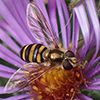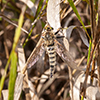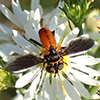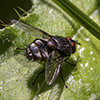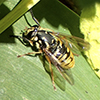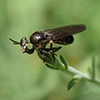Minnesota Flies
Diptera (flies) is the order of insects that is characterized as having a single pair of functional wings on the mesothorax and a pair of halteres, reduced, knob-like structures derived from the hind wings, on the metathorax. The order includes true flies, mosquitos, gnats, and midges.
There are more than 150,000 described, still living species worldwide, though there are thought to be about 1,000,000 species. There are about 17,000 species in North America north of Mexico, and at least 367 species in Minnesota.
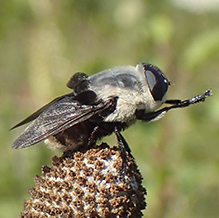
Recent Additions
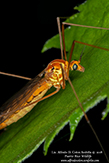
With over 15,000 described species, the family Tipulidae (crane flies) is one of the largest families of true flies (Diptera). More than 1,600 species occur in North America. The subfamily Tipulinae (large crane flies) contains the largest of the crane flies. In North America, the vast majority of species are in the genera Tipula and Nephrotoma. The genus Nephrotoma (tiger crane flies) contains about 150 described species. The most common of these is ferruginous tiger crane fly (Nephrotoma ferruginea).
“Ferruginous” means reddish-brown or rust colored, but ferruginous tiger crane fly is more often described as orange in color. It is distinguished from other crane flies by the body color, the antennae that are entirely black except for the first two segments, and by a black spot at each end of a groove across the thorax.
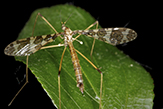
Band-winged crane fly (Epiphragma fasciapenne) is a common, easily identified, moderate-sized crane fly. It occurs in the eastern United States and adjacent Canadian provinces east of the Great Plains. Eastern Minnesota is at the western edge of its range. It is found in floodplain woodlands and wooded areas adjacent to swamps.
Like all crane flies, the body is long and slim, the wings are long and narrow, and the legs are very long, very thin, and very fragile. The thorax has a distinct, V-shaped groove on top. The lower jaws each have a very long, antenna-like extension.
Band-winged crane fly is distinguished by the distinctive wing pattern with four bands of bordered brown spots, and by a dark brown band at the very tip of the third leg segment.
_01it.jpg)
Eumerus is a genus of small hoverflies in the family Syrphidae. With 281 known species, it is one of the largest genera of flies. It is found throughout the Palearctic realm, which includes Europe, Asia north of the Himalayas, North Africa, and the northern and central parts of the Arabian Peninsula. Several Eumerus species have been introduced into North and South America. Three of these are known to occur in the United States: lesser bulb fly (Eumerus funeralis), narcissus bulb fly (Eumerus narcissi), and onion bulb fly (Eumerus strigatus). Collectively, they are known as lesser bulb flies.
Adult lesser bulb flies are black tinged with bronze. They have pale longitudinal stripes on the thorax and silvery-white stripes on the abdomen. The larvae are considered pests. They tunnel into plant bulbs, causing the bulbs to rot. The bulb either dies or produces stunted growth in the following growing season. In some areas, up to 25% of narcissus bulbs are infected.
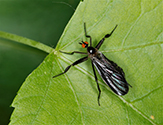
Long-tailed dance fly (Rhamphomyia longicauda) is a small, black, long-legged fly. It is commonly found from May to July in deciduous woods near water. The wings are long and black. The head is round with large bright orange or red eyes. On the female, the middle and hind legs have a fringe of long, black, bristly hairs.
Every evening around sunset, males and females collect in same-sex swarms. Females and fly up and down, the behavior that gives this family its common name “dance-flies”. Females cannot hunt for prey. They receive protein from males as gifts in exchange for copulation. They swallow air, filling and extending their abdomen outward, saucer-like, falsely signaling males that their eggs are nearing maturity. The long hairy legs wrap around the abdomen, making it appear even larger. Males are attracted to females that have largest swollen abdomens and hairiest legs. An individual will break off and join the other swarm to select a mate.
_01it.jpg)
With 7,003 species in 530 genera worldwide, robber flies are one of the largest and most abundant families of insects alive today. Bee-like robber flies, as the common name for the genus suggests, resemble bees. There are 240 species of bee-like robber flies, 62 species in North America north of Mexico. Few of the species have been given a common name.
Yellow-waisted laphria (Laphria sacrator) is a short, robust, medium-sized, bee-like robber fly. It is fairly common in northeastern and north-central United States, including Minnesota. It has a stout thorax and a short abdomen, both partially covered with long yellow hairs making it resemble a bumble bee. It is one of the hairiest of the bee-like robber flies. Adults are ⅝″ to 1″ long.
Other Recent Additions
This list includes only flies that have been recorded in Minnesota, but not all of the flies found in Minnesota.
| A | |||||
|---|---|---|---|---|---|
| Profile | Photo | Video | |||
American harlequin (Xanthogramma flavipes) |
|||||
American serpentine leaf miner (Liriomyza trifolii) |
|||||
antlered crane fly (Tanyptera dorsalis) |
|||||
ashy laphria (Laphria cinerea) |
|||||
|
|||||
|
|||||
|
|||||
|
|||||
|
|||||
|
|||||
|
|||||
|
|||||
|
|||||
|
| B | |||||
|---|---|---|---|---|---|
| Profile | Photo | Video | |||
bald deer fly (Chrysops calvus) |
|||||
banded bee fly (Exoprosopa fasciata) |
|||||
band-winged bee fly (Exoprosopa fascipennis) |
|||||
bare-winged aphideater (Eupeodes perplexus) |
|||||
bee flies (Family Bombylidae) |
|||||
beautiful deer fly (Chrysops callidus) |
|||||
benign deer fly (Chrysops mitis) |
|||||
bird hover fly (Eupeodes volucris) |
|||||
black deer fly (Chrysops niger) |
|||||
black fly (Family Simuliidae) |
|||||
black scavenger fly (Sepsis punctum) |
|||||
black spur fly (Teuchocnemis lituratus) |
|||||
black-footed globetail (Sphaerophoria philanthus) |
|||||
black-horned pufftail (Sphegina rufiventris) |
|||||
blackjack oak leaf gall midge (Polystepha globosa) |
|||||
black-legged bog fly (Parhelophilus flavifacies) |
|||||
blackshield meadow fly (Chrysotoxum flavifrons) |
|||||
black-spotted falsehorn (Temnostoma excentrica) |
|||||
black-thighed bladetail (Machimus notatus) |
|||||
black-waisted laphria (Laphria divisor) |
|||||
bog horse fly (Hybomitra illota) |
|||||
bot flies, blow flies, and allies (Superfamily Oestroidea) |
|||||
bothersome deer fly (Chrysops excitans) |
|||||
broad-banded hornet fly (Spilomyia alcimus) |
|||||
broad-striped globetail (Sphaerophoria brevipilosa) |
|||||
Brooks’ bog fly (Parhelophilus brooksi) |
|||||
brown robber fly (Proctacanthella cacopiliga) |
|||||
brown-footed horse fly (Tabanus fulvicallus) |
|||||
burdock leafminer (Liriomyza arctii) |
|||||
burr-seed fly (Euaresta aequalis) |
|||||
|
|||||
|
|||||
|
|||||
|
|||||
|
|||||
|
|||||
|
|||||
|
|||||
|
|||||
|
|||||
|
|||||
|
| C | |||||
|---|---|---|---|---|---|
| Profile | Photo | Video | |||
cabbage leafminer (Liriomyza brassicae) |
|||||
cattail mosquito (Coquillettidia perturbans) |
|||||
chained horse fly (Tabanus catenatus) |
|||||
charcoal deer fly (Chrysops carbonarius) |
|||||
cluster fly (Pollenia labiais) |
|||||
common bog fly (Parhelophilus laetus) |
|||||
common cluster fly (Pollenia rudis) |
|||||
common crane fly (Tipula caloptera) |
|||||
common crane fly (Tipula dorsimacula) |
|||||
common house fly (Musca domestica) |
|||||
common thickleg (Tropidia quadrata) |
|||||
|
|||||
|
|||||
|
|||||
|
|||||
|
|||||
|
|||||
|
|||||
|
|||||
|
|||||
|
|||||
|
|||||
|
|||||
|
|||||
|
|||||
|
|||||
|
|||||
|
|||||
|
|||||
|
|||||
|
|||||
|
|||||
|
|||||
|
|||||
|
|||||
|
|||||
|
|||||
|
|||||
|
|||||
|
| D | |||||
|---|---|---|---|---|---|
| Profile | Photo | Video | |||
dance fly (Rhamphomyia fumosa) |
|||||
dance fly (Rhamphomyia irregularis) |
|||||
dance fly (Rhamphomyia luteiventris) |
|||||
dance fly (Rhamphomyia pulla) |
|||||
dark deer fly (Chrysops ater) |
|||||
Dawson’s deer fly (Chrysops dawsoni) |
|||||
daylily leafminer (Ophiomyia kwansonis) |
|||||
deer flies (Chrysops spp.) |
|||||
devil’s leafwalker (Chalcosyrphus satanicus) |
|||||
dimorphic sickleleg (Polydontomyia curvipes) |
|||||
dung fly (Cordilura varipes) |
|||||
dung fly (Scathophaga furcata) |
|||||
dusky bog fly (Parhelophilus rex) |
|||||
dusky drone dly (Eristalis obscura) |
|||||
dusky mucksucker (Orthonevra pulchella) |
|||||
dusky-banded leafwalker (Chalcosyrphus nemorum) |
|||||
dusky-veined mucksucker (Orthonevra pictipennis) |
| E | |||||
|---|---|---|---|---|---|
| Profile | Photo | Video | |||
eastern catkin fly (Brachypalpus oarus) |
|||||
eastern swiftwing (Volucella evecta) |
|||||
eastern treehole mosquito (Aedes triseriatus) |
|||||
ebony pithead (Pipiza atrata) |
|||||
elm agromyzid leafminer (Agromyza aristata) |
|||||
epistate horse fly (Hybomitra epistates) |
|||||
European drone fly (Eristalis arbustorum) |
|||||
European tachinid fly (Compsilura concinnata) |
|||||
|
|||||
|
| F | |||||
|---|---|---|---|---|---|
| Profile | Photo | Video | |||
face fly (Musca autumnalis) |
|||||
fen flies (Neoascia spp.) |
|||||
filthy deer fly (Chrysops sordidus) |
|||||
flat-footed flies (Platypeza spp.) |
|||||
four-barred knapweed gall fly (Urophora quadrifasciata) |
|||||
four-spotted leafwalker (Xylota quadrimaculata) |
|||||
friendly fly (Sarcophaga aldrichi) |
|||||
frigid deer fly (Chrysops frigidus) |
|||||
fruit fly (Dioxyna picciola) |
|||||
furious deer fly (Chrysops aestuans) |
|||||
|
|||||
|
|||||
|
|||||
|
|||||
|
|||||
|
|||||
|
|||||
|
|||||
|
|||||
|
| G | |||||
|---|---|---|---|---|---|
| Profile | Photo | Video | |||
gall midge (Harmandiola cavernosa) |
|||||
gall midge (Rhopalomyia artemisiae) |
|||||
gall midge (Rhopalomyia baccarum) |
|||||
gall midges (Subfamily Cecidomyiinae) |
|||||
Gemeni deer fly (Chrysops geminatus) |
|||||
giant crane fly (Tipula abdominalis) |
|||||
giant ragweed fruit fly (Euaresta festiva) |
|||||
globetails (Sphaerophoria spp.) |
|||||
goldenback (Pterallastes thoracicus) |
|||||
goldenrod brussels sprout gall fly (Procecidochares atra) |
|||||
grape gall midge (Schizomyia vitiscoryloides) |
|||||
grass fly (Thaumatomyia grata) |
|||||
|
|||||
|
|||||
|
|||||
|
|||||
|
|||||
|
|
||||
|
|||||
|
|||||
|
|||||
|
|||||
|
|||||
|
|||||
|
|||||
|
|||||
|
|||||
|
| H | |||||
|---|---|---|---|---|---|
| Profile | Photo | Video | |||
hairy-eyed mimic (Mallota posticata) |
|||||
Hine’s leafwalker (Xylota hinei) |
|||||
horse fly (Tabanus turbidus) |
|||||
hourglass drone fly (Eristalis brousii) |
|||||
house fly (Eudasyphora cyanicolor) |
|||||
Huron laphria (Laphria huron) |
|||||
hybotid dance flies (Tachypeza spp.) |
|||||
hybotid dance fly (Platypalpus trivialis) |
|||||
|
|||||
|
|||||
|
|||||
|
|||||
|
|||||
|
|||||
|
| I | |||||
|---|---|---|---|---|---|
| Profile | Photo | Video | |||
inland floodwater mosquito (Aedes vexans) |
|||||
|
| J | |||||
|---|---|---|---|---|---|
| Profile | Photo | Video | |||
jewelweed leaf-miner fly (Phytoliriomyza melampyga) |
|||||
|
| K | |||||
|---|---|---|---|---|---|
| Profile | Photo | Video | |||
|
|||||
|
| L | |||||
|---|---|---|---|---|---|
| Profile | Photo | Video | |||
lance flies (Lonchaea spp.) |
|||||
large crane flies (Dolichopeza spp.) |
|||||
large crane fly (Angarotipula illustris) |
|||||
large crane fly (Platytipula ultima) |
|||||
large-spotted leafwalker (Xylota subfaciata) |
|||||
leaf miner fly (Agromyza vockerothi) |
|||||
leaf miner fly (Aulagromyza cornigera) |
|||||
leaf miner fly (Calycomyza flavinotum) |
|||||
leaf miner fly (Calycomyza promissa) |
|||||
leaf miner fly (Liriomyza eupatorii) |
|||||
leaf miner fly (Nemorimyza posticata) |
|||||
leaf miner fly (Ophiomyia maura) |
|||||
leaf miner fly (Phytomyza agromyzina) |
|||||
leaf miner fly (Phytomyza aralivora) |
|||||
lesser bulb fly (Eumerus funeralis) |
|||||
lesser house fly (Fannia canicularis) |
|||||
limoniid crane fly (Antocha saxicola) |
|||||
limoniid crane fly (Erioptera chlorophylla) |
|||||
limoniid crane fly (Gnophomyia tristissima) |
|||||
long hoverfly (Sphaerophoria scripta) |
|||||
long-horned yellowjacket fly (Sphecomyia vittata) |
|||||
longlegged fly (Condylostylus longicornis) |
|||||
long-nosed swamp fly (Eurimyia stipata) |
|||||
longspine leafwalker (Xylota annulifera) |
|||||
long-spined pufftail (Sphegina petiolata) |
|||||
long-tailed aphideater complex (Eupeodes americanus complex) |
|||||
low-horned wrinkleheads (Chrysogaster spp.) |
|||||
lump-legged swamp fly (Anasimyia chrysostoma) |
|||||
|
|||||
|
|||||
|
| M | |||||
|---|---|---|---|---|---|
| Profile | Photo | Video | |||
mallow leaf miner (Calycomyza malvae) |
|||||
march fly (Bibio femoratus) |
|||||
marginal horse fly (Tabanus marginalis) |
|||||
marsh crane fly (Tipula oleracea) |
|||||
marsh fly (Tetanocera valida) |
|||||
marsh fly (Trypetoptera canadensis) |
|||||
marsh greenbottle fly (Lucilia silvarum) |
|||||
marsh snipe fly (Rhagio tringarius) |
|||||
meadow fly (Chrysotoxum fasciolatum) |
|||||
midwestern mimic (Mallota illinoensis) |
|||||
milkweed leaf-miner fly (Liriomyza asclepiadis) |
|||||
mosquitoes (Aedes spp.) |
|||||
|
|||||
|
|||||
|
|||||
|
|||||
|
|||||
|
|||||
|
| N | |||||
|---|---|---|---|---|---|
| Profile | Photo | Video | |||
narrow-banded meadow fly (Chrysotoxum derivatum) |
|||||
narrow-banded pond fly (Sericomyia militaris) |
|||||
non-biting midge (Acamptocladius dentolatens) |
|||||
non-biting midge (Chironomus atroviridis) |
|||||
non-biting midge (Chironomus riparius) |
|||||
non-biting midge (Diplocladius cultriger) |
|||||
non-biting midge (Hyporhygma quadripunctatus) |
|||||
non-biting midge (Kribiodorum perpulchrum) |
|||||
non-biting midge (Lauterborniella agrayloides) |
|||||
non-biting midge (Psectrotanypus dyari) |
|||||
non-biting midge (Sublettea coffmani) |
|||||
non-biting midge (Xenochironomus xenolabis) |
|||||
non-biting midge (Xylotopus par) |
|||||
non-biting midge (Zavreliella marmorata) |
|||||
non-biting midges (Family Chironomidae) |
|||||
Nova Scotia horse fly (Tabanus novaescotiae) |
| O | |||||
|---|---|---|---|---|---|
| Profile | Photo | Video | |||
oak apple gall wasps (Amphibolips spp.) |
|||||
oak shothole leafminer (Japanagromyza viridula) |
|||||
oblique-banded pond fly (Sericomyia chrysotoxoides) |
|||||
one-striped deer fly (Chrysops univittatus) |
|||||
onion bulb fly (Eumerus strigatus) |
|||||
orange-hipped leafwalker (Chalcosyrphus vecors) |
|||||
orange-spined drone fly (Eristalis interrupta) |
|||||
orange-tailed laphria (Laphria janus) |
|||||
|
|||||
|
|||||
|
|||||
|
|||||
|
|||||
|
|||||
|
|||||
|
| P | |||||
|---|---|---|---|---|---|
| Profile | Photo | Video | |||
peacock fly (Callopistromyia annulipes) |
|||||
picture-winged fly (Callopistromyia strigula) |
|||||
picture-winged fly (Idana marginata) |
|||||
picture-winged fly (Tritoxa incurva) |
|||||
polished leafwalker (Xylota ejuncida) |
|||||
pond olive (Cloeon dipterum) |
|||||
poplar twiggall fly (Euhexomyza schineri) |
|||||
prairie lion fly (Promachus fitchii) |
|||||
| Q | |||||
|---|---|---|---|---|---|
| Profile | Photo | Video | |||
|
|||||
|
|||||
|
| R | |||||
|---|---|---|---|---|---|
| Profile | Photo | Video | |||
rabbit bot fly (Cuterebra buccata) |
|||||
radiant laphria (Laphria atkis) |
|||||
Reinwardt’s horse fly (Tabanus reinwardtii) |
|||||
remarkable laphria (Laphria insignis) |
|||||
ring-clawed deer fly (Chrysops cincticornis) |
|||||
rodent bot fly (Cuterebra abdominalis) |
|||||
rodent bot fly (Cuterebra grisea) |
|||||
rodent bot fly (Cuterebra sterilator) |
|||||
rust fly (Loxocera cylindrica) |
|||||
|
|||||
|
|||||
|
| S | |||||
|---|---|---|---|---|---|
| Profile | Photo | Video | |||
Sacken’s deer fly (Chrysops sackeni) |
|||||
sage horse fly (Tabanus sagax) |
|||||
sand hammertail (Efferia albibarbis) |
|||||
scaled pegleg (Myolepta strigilata) |
|||||
Sherman’s deer fly (Chrysops shermani) |
|||||
shiny-sided bladetail (Machimus sadyates) |
|||||
shortgrass deer fly (Chrysops fulvaster) |
|||||
short-haired leafwalker (Chalcosyrphus piger) |
|||||
short-spined leafwalker (Xylota tuberculata) |
|||||
signal fly (Rivellia cognata) |
|||||
signal fly (Rivellia coquilletti) |
|||||
signal fly (Rivellia flavimana) |
|||||
signal fly (Rivellia melliginis) |
|||||
signal fly (Rivellia metallica) |
|||||
signal fly (Rivellia munda) |
|||||
signal fly (Rivellia pallida) |
|||||
signal fly (Rivellia steyskali) |
|||||
signal fly (Rivellia variabilis) |
|||||
signal fly (Rivellia viridulans) |
|||||
signal fly (Rivellia winifredae) |
|||||
silky laphria (Laphria sericea) |
|||||
similar horse fly (Tabanus similis) |
|||||
snipe flies (Rhagio spp.) |
|||||
snipe fly (Chrysopilus modestus) |
|||||
snipe fly (Chrysopilus proximus) |
|||||
soldier fly (Odontomyia virgo) |
|||||
soldier fly (Stratiomys badia) |
|||||
soldier fly (Stratiomys bruneri) |
|||||
soldier fly (Stratiomys meigenii) |
|||||
soldier fly (Stratiomys normula) |
|||||
southern arrowhead laphria (Laphria ithypyga) |
|||||
spot-headed aphideater (Eupeodes neoperplexus) |
|||||
spotted wood fly (Somula decora) |
|||||
squirrel bot fly (Cuterebra emasculator) |
|||||
stable fly (Stomoxys calcitrans) |
|||||
stilt-legged fly (Compsobata univitta) |
|||||
striated deer fly (Chrysops striatus) |
|||||
striped horse fly (Tabanus lineola) |
|||||
stygian horse fly (Tabanus stygius) |
|||||
sumac gall pithead (Pipiza puella) |
|||||
sunflower bullet gall midge (Pilodiplosis helianthibulla) |
|||||
sunflower maggot fly (Strauzia longipennis) |
|||||
sunflower receptacle maggot (Gymnocarena diffusa) |
|||||
sunflower seed maggot (Neotephritis finalis) |
|||||
| T | |||||
|---|---|---|---|---|---|
| Profile | Photo | Video | |||
tachinid fly (Admontia degeerioides) |
|||||
tachinid fly (Cylindromyia argentia) |
|||||
tachinid fly (Cylindromyia bicolor) |
|||||
tachinid fly (Cylindromyia carolinae) |
|||||
tachinid fly (Cylindromyia euchenor) |
|||||
tachinid fly (Gymnoclytia immaculata) |
|||||
tachinid fly (Gymnoclytia occidua) |
|||||
thick-headed fly (Dalmannia nigriceps) |
|||||
thick-headed fly (Myopa vicaria) |
|||||
thick-headed fly (Physocephala marginata) |
|||||
thick-headed fly (Physocephala texana) |
|||||
thick-headed fly (Physoconops brachyrhynchus) |
|||||
thick-headed fly (Stylogaster neglecta) |
|||||
thick-headed fly (Thecophora occidensis) |
|||||
three-banded robber fly (Stichopogon trifasciatus) |
|||||
three-spotted horse fly (Tabanus trimaculatus) |
|||||
tufted cluster fly (Pollenia pediculata) |
|||||
twigsitters (Holopogon spp.) |
|||||
two-lined swamp fly (Anasimyia bilinearis) |
|||||
two-spotted leafwalker (Xylota angustiventris) |
|||||
|
|||||
|
|||||
|
|||||
|
|||||
|
|||||
|
|||||
|
|||||
|
|||||
|
|||||
|
|||||
|
|||||
|
|||||
|
|||||
|
|||||
|
|||||
|
|||||
|
| U | |||||
|---|---|---|---|---|---|
| Profile | Photo | Video | |||
unadorned bog fly (Parhelophilus obsoletus) |
|||||
|
| V | |||||
|---|---|---|---|---|---|
| Profile | Photo | Video | |||
vagabond cluster fly (Pollenia vagabunda) |
|||||
variable aphideater (Eupeodes latifasciatus) |
|||||
Vockeroth twigsitter (Holopogon vockerothi) |
|||||
|
| W | |||||
|---|---|---|---|---|---|
| Profile | Photo | Video | |||
walnut husk maggot fly (Rhagoletis suavis) |
|
||||
wandering deer fly (Chrysops aberrans) |
|||||
water snipe fly (Atherix variegata) |
|||||
waved light fly (Pyrgota undata) |
|||||
wavy mucksucker (Orthonevra nitida) |
|||||
West Indies deer fly (Chrysops indus) |
|||||
white snakeroot leaf miner (Liriomyza eupatoriella) |
|||||
white-faced micropanther (Cerotainia albipilosa) |
|||||
white-haired pithead (Pipiza femoralis) |
|||||
Williston’s wasp fly (Sphiximorpha willistoni) |
|||||
willow catkin fly (Egle atomaria) |
|||||
willow catkin fly (Egle longipalpis) |
|||||
willow rosette gall midge (Rabdophaga salicisbrassicoides) |
|||||
Winnebago lake fly (Chironomus plumosus) |
|||||
winter crane fly (Trichocera spp.) |
|||||
winter midge (Diamesa mendotae) |
|||||
wood nettle gall midge (Dasineura investita) |
|||||
wood soldier fly (Xylomya aterrima) |
|||||
wood soldier fly (Xylomya tenthredinoides) |
|||||
| X | |||||
|---|---|---|---|---|---|
| Profile | Photo | Video | |||
|
|||||
|
| Y | |||||
|---|---|---|---|---|---|
| Profile | Photo | Video | |||
yellowjacket horse fly (Hybomitra zonalis) |
|||||
yellowjacket hover fly (Milesia virginiensis) |
|||||
yellow-faced micropanther (Cerotainia macrocera) |
|||||
yellow-faced swiftwing (Volucella facialis) |
|||||
yellow-haired falsehorn (Temnostoma balyras) |
|||||
yellow-sided deer fly (Chrysops lateralis) |
|||||
yellow-spotted pond fly (Sericomyia transversa) |
|||||
yellow-spotted sapeater (Brachyopa vacua) |
|||||
yellow-throated meadow fly (Chrysotoxum pubescens) |
|||||
|
| Z | |||||
|---|---|---|---|---|---|
| Profile | Photo | Video | |||
|
|||||
|
Acamptocladius dentolatens (non-biting midge)
Acericecis ocellaris (ocellate gall midge)
Admontia degeerioides (tachinid fly)
Admontia spp. (tachinid flies)
Aedes spp. (mosquitoes)
Aedes triseriatus (eastern treehole mosquito)
Aedes vexans (inland floodwater mosquito)
Agathomyia spp. (flat-footed fly)
Agromyza aristata (elm agromyzid leafminer)
Agromyza vockerothi (leaf miner fly)
Allograpta obliqua (oblique streaktail)
Amphibolips spp. (oak apple gall wasps)
Anasimyia bilinearis (two-lined swamp fly)
Anasimyia chrysostoma (lump-legged swamp fly)
Anastoechus barbatus (bearded bee fly)
Angarotipula illustris (large crane fly)
Anthomyiidae (root-maggot flies)
Antocha saxicola (limoniid crane fly)
Archytas apicifer (hornworm tachinid fly)
Asilus sericeus (butterflyhunter)
Atherix variegata (water snipe fly)
Aulagromyza cornigera (leaf miner fly)
Bibio albipennis (white-winged march fly)
Bibio femoratus (march fly)
Bombylidae (bee flies)
Brachyopa vacua (yellow-spotted sapeater)
Brachypalpus oarus (eastern catkin fly)
Callopistromyia annulipes (peacock fly)
Callopistromyia strigula (picture-winged fly)
Calycomyza flavinotum (leaf miner fly)
Calycomyza humeralis (aster leafminer)
Calycomyza malvae (mallow leaf miner)
Calycomyza promissa (leaf miner fly)
Calyptratae (calyptrate flies)
Campiglossa albiceps (fruit fly)
Cecidomyiinae (gall midges)
Cecidomyiidae (gall midges and wood midges)
Cerodontha dorsalis (grass sheathminer fly)
Cerotainia spp. (robber flies)
Cerotainia albipilosa (white-faced micropanther)
Cerotainia macrocera (yellow-faced micropanther)
Chalcosyrphus chalybeus (violet leafwalker)
Chalcosyrphus nemorum (dusky-banded leafwalker)
Chalcosyrphus piger (short-haired leafwalker)
Chalcosyrphus satanicus (devil’s leafwalker)
Chalcosyrphus vecors (orange-hipped leafwalker)
Chironomidae (non-biting midges)
Chironomini (non-biting midges)
Chironomus atroviridis (non-biting midge)
Chironomus plumosus (Winnebago lake fly)
Chironomus riparius (non-biting midge)
Chironomus spp. (non-biting midge)
Chrysogaster spp. (low-horned wrinkleheads)
Chrysopilus foedus (snipe fly)
Chrysopilus modestus (snipe fly)
Chrysopilus ornatus (ornate snipe fly)
Chrysopilus proximus (snipe fly)
Chrysopilus quadratus (quadrate snipe fly)
Chrysopilus thoracicus (golden-backed snipe fly)
Chrysops aberrans (wandering deer fly)
Chrysops aestuans (furious deer fly)
Chrysops ater (dark deer fly)
Chrysops callidus (beautiful deer fly)
Chrysops calvus (bald deer fly)
Chrysops carbonarius (charcoal deer fly)
Chrysops cincticornis (ring-clawed deer fly)
Chrysops dawsoni (Dawson’s deer fly)
Chrysops excitans (bothersome deer fly)
Chrysops frigidus (frigid deer fly)
Chrysops fulvaster (shortgrass deer fly)
Chrysops geminatus (Gemeni deer fly)
Chrysops indus (West Indies deer fly)
Chrysops lateralis (yellow-sided deer fly)
Chrysops macquarti (Macquart’s deer fly)
Chrysops mitis (benign deer fly)
Chrysops moechus (adulterous deer fly)
Chrysops montanus (mountain deer fly)
Chrysops niger (black deer fly)
Chrysops sackeni (Sacken’s deer fly)
Chrysops shermani (Sherman’s deer fly)
Chrysops sordidus (filthy deer fly)
Chrysops spp. (deer flies)
Chrysops striatus (striated deer fly)
Chrysops univittatus (one-striped deer fly)
Chrysops vittatus (striped deer fly)
Chrysotoxum derivatum (narrow-banded meadow fly)
Chrysotoxum fasciolatum (meadow fly)
Chrysotoxum flavifrons (blackshield meadow fly)
Chrysotoxum plumeum (broad-banded meadow fly)
Chrysotoxum pubescens (yellow-throated meadow fly)
Cloeon dipterum (pond olive)
Coenomyia ferruginea (stink fly)
Coenosia tigrina (common tiger fly)
Compsilura concinnata (European tachinid fly)
Compsobata univitta (stilt-legged fly)
Condylostylus caudatus complex (longlegged flies)
Condylostylus longicornis (longlegged fly)
Condylostylus patibulatus (longlegged fly)
Condylostylus sipho complex (longlegged flies)
Condylostylus spp. (longlegged flies)
Contarinia verrucicola (linden wart gall midge)
Coquillettidia perturbans (cattail mosquito)
Cordilura varipes (dung fly)
Cuterebra abdominalis (rodent bot fly)
Cuterebra buccata (rabbit bot fly)
Cuterebra emasculator (squirrel bot fly)
Cuterebra fontinella fontinella (mouse bot fly)
Cuterebra grisea (rodent bot fly)
Cuterebra spp. (rodent bot flies)
Cuterebra sterilator (rodent bot fly)
Cylindromyia argentia (tachinid fly)
Cylindromyia bicolor (tachinid fly)
Cylindromyia carolinae (tachinid fly)
Cylindromyia euchenor (tachinid fly)
Dalmannia nigriceps (thick-headed fly)
Dasineura investita (wood nettle gall midge)
Delphinia picta (common picture-winged fly)
Demeijerea brachialis (non-biting midge)
Diamesa mendotae (winter midge)
Didea fuscipes (undivided lucent)
Dioctria hyalipennis (stripe-legged robber fly)
Dioxyna picciola (fruit fly)
Dioprosopa clavata (four-speckled hover fly)
Diplocladius cultriger (non-biting midge)
Discobola annulata (limoniid crane fly)
Dolichopeza spp. (large crane flies)
Efferia aestuans (northeastern hammertail)
Efferia albibarbis (sand hammertail)
Egle atomaria (willow catkin fly)
Egle longipalpis (willow catkin fly)
Egle spp. (willow catkin flies)
Epalpus signifer (early tachinid fly)
Epiphragma fasciapenne (band-winged crane fly)
Epistrophe grossulariae (black-horned smoothtail)
Epistrophella emarginata (slender smoothtail)
Erioptera chlorophylla (limoniid crane fly)
Eristalis anthophorina (orange-spotted drone fly)
Eristalis arbustorum (European drone fly)
Eristalis brousii (hourglass drone fly)
Eristalis dimidiata (black-shouldered drone fly)
Eristalis flavipes (orange-legged drone fly)
Eristalis interrupta (orange-spined drone fly)
Eristalis obscura (dusky drone dly)
Eristalis stipator (yellow-shouldered drone fly)
Eristalis tenax (common drone fly)
Eristalis transversa (transverse flower fly)
Euaresta aequalis (burr-seed fly)
Euaresta bella (common ragweed fruit fly)
Euaresta festiva (giant ragweed fruit fly)
Eudasyphora cyanicolor (house fly)
Euhexomyza schineri (poplar twiggall fly)
Eumerus funeralis (lesser bulb fly)
Eumerus strigatus (onion bulb fly)
Eupeodes americanus (American hover fly)
Eupeodes americanus complex (long-tailed aphideater complex)
Eupeodes latifasciatus (variable aphideater)
Eupeodes neoperplexus (spot-headed aphideater)
Eupeodes perplexus (bare-winged aphideater)
Eupeodes pomus (short-tailed aphideater)
Eupeodes Subgenus Metasyrphus (aphideaters)
Eupeodes volucris (bird hover fly)
Eurimyia stipata (long-nosed swamp fly)
Eurosta solidaginis (goldenrod gall fly)
Eutreta novaeboracensis (fruit fly)
Exoprosopa decora (adorned bee fly)
Exoprosopa fasciata (banded bee fly)
Exoprosopa fascipennis (band-winged bee fly)
Fannia canicularis (lesser house fly)
Gnophomyia tristissima (limoniid crane fly)
Gymnocarena diffusa (sunflower receptacle maggot)
Gymnoclytia immaculata (tachinid fly)
Gymnoclytia occidua (tachinid fly)
Harmandiola cavernosa (gall midge)
Hedriodiscus binotatus (green soldier fly)
Helius flavipes (limoniid crane fly)
Helophilus fasciatus (narrow-headed marsh fly)
Helophilus hybridus (woolly-tailed marsh fly)
Helophilus latifrons (broad-headed marsh fly)
Holcocephala abdominalis (golden goggle eye)
Holcocephala calva (gray goggle eye)
Holcocephala spp. (gnat ogres)
Holopogon spp. (twigsitters)
Holopogon vockerothi (Vockeroth twigsitter)
Hybomitra epistates (epistate horse fly)
Hybomitra illota (bog horse fly)
Hybomitra lasiophthalma (orange-sided horse fly)
Hybomitra zonalis (yellowjacket horse fly)
Hydrophoria lancifer (root-maggot fly)
Hypocritanus fascipennis (eastern band-winged hover fly)
Hyporhygma quadripunctatus (non-biting midge)
Idana marginata (picture-winged fly)
Japanagromyza viridula (oak shothole leafminer)
Kribiodorum perpulchrum (non-biting midge)
Laphria atkis (radiant laphria)
Laphria canis complex (bee-mimic robber flies)
Laphria cinerea (ashy laphria)
Laphria divisor (black-waisted laphria fly)
Laphria flavicollis (black-tailed laphria)
Laphria huron (Huron laphria)
Laphria index (arrowhead laphria)
Laphria index complex (bee-mimic robber flies)
Laphria insignis (remarkable laphria)
Laphria ithypyga (southern arrowhead laphria)
Laphria janus (orange-tailed laphria)
Laphria posticata (boreal laphria)
Laphria sacrator (yellow-waisted laphria)
Laphria sericea (silky laphria)
Laphria sericea complex (bee-mimic robber flies)
Laphria spp. (bee-mimic robber flies)
Laphria thoracica (eastern yellow-backed laphria)
Lauterborniella agrayloides (non-biting midge)
Lepidophora lepidocera (scaly bee fly)
Lepidophora lutea (hunchback bee fly)
Liriomyza arctii (burdock leafminer)
Liriomyza asclepiadis (milkweed leaf-miner fly)
Liriomyza brassicae (cabbage leafminer)
Liriomyza eupatoriella (white snakeroot leaf miner)
Liriomyza eupatorii (leaf miner fly)
Liriomyza spp. (leaf miner flies)
Liriomyza trifolii (American serpentine leaf miner)
Lonchaea spp. (lance flies)
Loxocera cylindrica (rust fly)
Lucilia coeruleiviridis (blue-green bottle fly)
Lucilia sericata (common green bottle fly)
Lucilia silvarum (marsh greenbottle fly)
Machimus notatus (black-thighed bladetail)
Machimus sadyates (shiny-sided bladetail)
Mallota bautias (bare-eyed mimic)
Mallota illinoensis (midwestern mimic)
Mallota posticata (hairy-eyed mimic)
Melanostoma mellinum (variable duskyface fly)
Merodon equestris (narcissus bulb fly)
Microtendipes pedellus (small red midge)
Milesia virginiensis (yellowjacket hover fly)
Milichiidae (freeloader flies)
Musca autumnalis (face fly)
Musca domestica (common house fly)
Myolepta strigilata (scaled pegleg)
Myopa clausa (thick-headed fly)
Myopa vicaria (thick-headed fly)
Nemorimyza posticata (leaf miner fly)
Nemotelus kansensis (soldier fly)
Neoascia spp. (fen flies)
Neotephritis finalis (sunflower seed maggot)
Odontomyia incta (soldier fly)
Odontomyia cincta (soldier fly)
Oestroidea (bot flies, blow flies, and allies)
Ophiomyia kwansonis (daylily leafminer)
Ophiomyia maura (leaf miner fly)
Orthonevra nitida (wavy mucksucker)
Orthonevra pictipennis (dusky-veined mucksucker)
Orthonevra pulchella (dusky mucksucker)
Parhelophilus brooksi (Brooks’ bog fly)
Parhelophilus flavifacies (black-legged bog fly)
Parhelophilus laetus (common bog fly)
Parhelophilus obsoletus (unadorned bog fly)
Parhelophilus rex (dusky bog fly)
Pelecinobaccha costata (cobalt hover fly)
Physocephala furcillata (thick-headed fly)
Physocephala marginata (thick-headed fly)
Physocephala sagittaria (thick-headed fly)
Physocephala texana (thick-headed fly)
Physocephala tibialis (common eastern physocephala)
Physoconops brachyrhynchus (thick-headed fly)
Physoconops obscuripennis (thick-headed fly)
Phytoliriomyza melampyga (jewelweed leaf-miner fly)
Phytomyza agromyzina (leaf miner fly)
Phytomyza aralivora (leaf miner fly)
Pilodiplosis helianthibulla (sunflower bullet gall midge)
Pipiza atrata (ebony pithead)
Pipiza femoralis (white-haired pithead)
Pipiza puella (sumac gall pithead)
Platycheirus spp. (sedgesitters)
Platypalpus spp. (hybotid dance fly)
Platypalpus trivialis hybotid dance fly)
Platypeza spp. (flat-footed flies)
Platypezinae (flat-footed flies)
Platystoma seminationis (dancing kiss fly)
Platytipula ultima (large crane fly)
Pollenia labiais (cluster fly)
Pollenia pediculata (tufted cluster fly)
Pollenia rudis (common cluster fly)
Pollenia vagabunda (vagabond cluster fly)
Polydontomyia curvipes (dimorphic sickleleg)
Polystepha globosa (blackjack oak leaf gall midge)
Polystepha pilulae (oak leaf gall midge)
Procecidochares atra (goldenrod brussels sprout gall fly)
Proctacanthella cacopiliga (brown robber fly)
Proctacanthus milbertii (Milbert’s proctacanthus)
Promachus bastardii (false bee-killer)
Promachus fitchii (prairie lion fly)
Promachus vertebratus (spot-tailed lion fly)
Psectrotanypus dyari (non-biting midge)
Pseudoseioptera albipes (picture-winged fly)
Pterelachisus (common crane flies)
Pterallastes thoracicus (goldenback)
Pyrgota undata (waved light fly)
Rabdophaga salicisbrassicoides (willow rosette gall midge)
Rabdophaga strobiloides (willow pinecone gall midge)
Rainieria antennaepes (stilt-legged fly)
Rhagio mystaceus (common snipe fly)
Rhagio spp. (snipe flies)
Rhagio tringarius (marsh snipe fly)
Rhagoletis suavis (walnut husk maggot fly)
Rhamphomyia fumosa (dance fly)
Rhamphomyia irregularis (dance fly)
Rhamphomyia longicauda (long-tailed dance fly)
Rhamphomyia luteiventris (dance fly)
Rhamphomyia pulla (dance fly)
Rhamphomyia spp. (dance flies)
Rhamphomyia vittata (dance fly)
Rhingia nasica (American snout fly)
Rhopalomyia artemisiae (gall midge)
Rhopalomyia baccarum (gall midge)
Rhopalomyia solidaginis (goldenrod bunch gall midge)
Rivellia cognata (signal fly)
Rivellia coquilletti (signal fly)
Rivellia flavimana (signal fly)
Rivellia melliginis (signal fly)
Rivellia metallica (signal fly)
Rivellia munda (signal fly)
Rivellia pallida (signal fly)
Rivellia quadrifasciata (soybean nodule fly)
Rivellia quadrifasciata or Rivellia colei (signal fly)
Rivellia steyskali (signal fly)
Rivellia variabilis (signal fly)
Rivellia viridulans (signal fly)
Rivellia winifredae (signal fly)
Sarcophaga aldrichi (friendly fly)
Sarcophaga africa (red-tailed flesh fly)
Scathophaga furcata (dung fly)
Scathophaga stercoraria (golden dung fly)
Schizomyia vitiscoryloides (grape gall midge)
Sciaridae (dark-winged fungus gnats)
Sepsis punctum (black scavenger fly)
Sericomyia chrysotoxoides (oblique-banded pond fly)
Sericomyia lata (white-spotted pond fly)
Sericomyia militaris (narrow-banded pond fly)
Sericomyia transversa (yellow-spotted pond fly)
Simuliidae (black fly)
Somula decora (spotted wood fly)
Sparnopolius confusus (aster bee fly)
Sphaeroceridae (lesser dung fly)
Sphaerophoria brevipilosa (broad-striped globetail)
Sphaerophoria contigua (tufted globetail)
Sphaerophoria philanthus (black-footed globetail)
Sphaerophoria scripta (long hoverfly)
Sphaerophoria spp. (globetails)
Sphecomyia vittata (long-horned yellowjacket fly)
Sphegina campanulata (orange-horned hammertail)
Sphegina petiolata (long-spined pufftail)
Sphegina rufiventris (black-horned pufftail)
Sphegina subg. Asiosphegina (pufftails)
Sphiximorpha willistoni (Williston’s wasp fly)
Spilomyia alcimus (broad-banded hornet fly)
Spilomyia fusca (bald-faced hornet fly)
Spilomyia longicornis (eastern hornet fly)
Spilomyia sayi (four-lined hornet fly)
Stichopogon trifasciatus (three-banded robber fly)
Stomoxys calcitrans (stable fly)
Stonemyia rasa (shaved horse fly)
Stratiomys adelpha or discalis (soldier fly)
Stratiomys badia (soldier fly)
Stratiomys bruneri (soldier fly)
Stratiomys meigenii (soldier fly)
Stratiomys norma (soldier fly)
Stratiomys normula (soldier fly)
Strauzia longipennis (sunflower maggot fly)
Stylogaster neglecta (thick-headed fly)
Suillia quinquepunctata (heleomyzid fly)
Syritta pipiens (common compost fly)
Syrphus rectus (yellow-legged flower fly)
Syrphus ribesii (common flower fly)
Tabanus atratus (black horse fly)
Tabanus catenatus (chained horse fly)
Tabanus fulvicallus (brown-footed horse fly)
Tabanus lineola (striped horse fly)
Tabanus marginalis (marginal horse fly)
Tabanus novaescotiae (Nova Scotia horse fly)
Tabanus reinwardtii (Reinwardt’s horse fly)
Tabanus sagax (sage horse fly)
Tabanus similis (similar horse fly)
Tabanus spp. (true horse flies)
Tabanus stygius (stygian horse fly)
Tabanus trimaculatus (three-spotted horse fly)
Tabanus turbidus (horse fly)
Tachypeza spp. (hybotid dance flies)
Tanyptera dorsalis (antlered crane fly)
Temnostoma alternans (wasp-like falsehorn)
Temnostoma balyras (yellow-haired falsehorn)
Temnostoma barberi (bare-bellied falsehorn)
Temnostoma excentrica (black-spotted falsehorn)
Tetanocera plebeja (marsh fly)
Tetanocera valida (marsh fly)
Teuchocnemis lituratus (black spur fly)
Thaumatomyia glabra (grass fly)
Thaumatomyia grata (grass fly)
Thecophora occidensis (thick-headed fly)
Thelaira americana (tachinid fly)
Tipula abdominalis (giant crane fly)
Tipula borealis (common crane fly)
Tipula caloptera (common crane fly)
Tipula dorsimacula (common crane fly)
Tipula furca (common crane fly)
Tipula oleracea (marsh crane fly)
Tipula paludosa (European crane fly)
Tipula spp. (common crane flies)
Tipula submaculata (common crane fly)
Tipula trivittata (common crane fly)
Toxomerus geminatus (eastern calligrapher)
Toxomerus marginatus (margined calligrapher)
Toxomerus politus (maize calligrapher)
Toxonevra superba (antlered flutter fly)
Trichocera spp. (winter crane fly)
Trichopoda pennipes (swift feather-legged fly)
Tritoxa flexa (black onion fly)
Tritoxa incurva (picture-winged fly)
Tropidia quadrata (common thickleg)
Trupanea actinobola (fruit fly)
Trypetoptera canadensis (marsh fly)
Urophora cardui (Canada thistle stem gall fly)
Urophora quadrifasciata (four-barred knapweed gall fly)
Volucella evecta (eastern swiftwing)
Volucella facialis (yellow-faced swiftwing)
Xanthogramma flavipes (American harlequin)
Xanthomelanodes arcuatus (tachinid fly)
Xenochironomus xenolabis (non-biting midge)
Xylomya americana (wood soldier fly)
Xylomya aterrima (wood soldier fly)
Xylomya tenthredinoides (wood soldier fly)
Xylomya terminalis (wood soldier fly)
Xylota angustiventris (two-spotted leafwalker)
Xylota annulifera (longspine leafwalker)
Xylota ejuncida (polished leafwalker)
Xylota hinei (Hine’s leafwalker)
Xylota quadrimaculata (four-spotted leafwalker)
Xylota subfaciata (large-spotted leafwalker)
Xylota spp. (leafwalkers and forest flies)
Xylota tuberculata (short-spined leafwalker)
Xylotopus par (non-biting midge)
Zavreliella marmorata (non-biting midge)
No Species Page Yet?
If you do not see a linked page for a species in the list at left you can still upload a photo or video or report a sighting for that species. Click on one of the buttons below and type in the common name and/or scientific name of the species in your photo, video, or sighting. A new page will be created for that species featuring your contribution.
These buttons not working for you?
Simply email us at info@MinnesotaSeasons.com.













































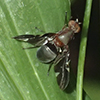















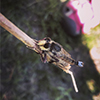















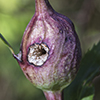









_01t.jpg)
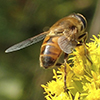






_01t.jpg)








